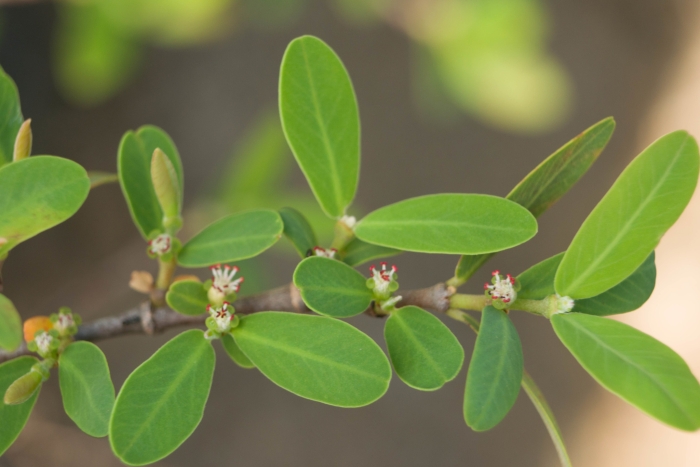’Akoko
(Euphorbia celastroides)
’Akoko (Euphorbia celastroides)
/
/

© Kevin Faccenda
CC BY 4.0
Image By:
© Kevin Faccenda
Recorded By:
Copyright:
CC BY 4.0
Copyright Notice:
Photo by: © Kevin Faccenda | License Type: CC BY 4.0 | License URL: http://creativecommons.org/licenses/by/4.0/ | Uploader: kevinfaccenda | Publisher: iNaturalist |

























Estimated Native Range
Summary
Euphorbia celastroides, commonly known as ’akoko, is a drought-tolerant shrub endemic to the Hawaiian Islands, particularly found in coastal dry shrublands and lowland dry forests. It can grow up to 6.6 feet tall and has a bushy, rounded form. The ’akoko has small, inconspicuous flowers that are typically yellowish-green, blooming throughout the year. The fruit is a three-lobed capsule that turns from green to brown as it matures. This species is valued for its hardiness in xeric landscapes and its ability to thrive in harsh conditions.
In cultivation, ’akoko is appreciated for its resilience to heat and drought, making it an excellent choice for water-wise gardens and restoration projects in dry areas. It prefers well-drained soils and can tolerate a range of soil types, from sandy to rocky substrates. While it can grow in light shade, it also tolerates full sun conditions. Gardeners should be aware that Euphorbia celastroides contains a milky sap that can be irritating to the skin and eyes. It is also vulnerable to threats such as habitat destruction from off-road vehicles and competition with introduced species.CC BY-SA 4.0
In cultivation, ’akoko is appreciated for its resilience to heat and drought, making it an excellent choice for water-wise gardens and restoration projects in dry areas. It prefers well-drained soils and can tolerate a range of soil types, from sandy to rocky substrates. While it can grow in light shade, it also tolerates full sun conditions. Gardeners should be aware that Euphorbia celastroides contains a milky sap that can be irritating to the skin and eyes. It is also vulnerable to threats such as habitat destruction from off-road vehicles and competition with introduced species.CC BY-SA 4.0
Plant Description
- Plant Type: Shrub, Tree
- Height: 1-3 feet
- Width: 1-3 feet
- Growth Rate: Moderate
- Flower Color: Red, Green
- Flowering Season: Spring, Summer
- Leaf Retention: Deciduous
Growth Requirements
- Sun: Full Sun
- Water: Low
- Drainage: Fast
Common Uses
Deer Resistant, Drought Tolerant, Erosion Control, Low Maintenance, Showy Flowers
Natural Habitat
Coastal dry shrublands and lowland dry forests in the Hawaiian Islands
Other Names
Common Names: Akoko, Koko, Beach Sandmat
Scientific Names: , Euphorbia celastroides, Chamaesyce celastroides, Chamaesyce celastroides var. amplectens, Chamaesyce celastroides var. halawana, Chamaesyce celastroides var. hanapepensis, Chamaesyce celastroides var. hathewayi, Chamaesyce celastroides var. haupuana, Chamaesyce celastroides var. humbertii, Chamaesyce celastroides var. ingrata
GBIF Accepted Name: